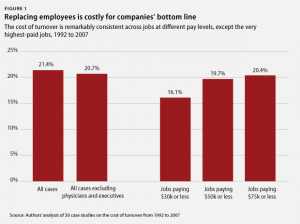For businesses that experience high levels of turnover, the cost of doing business adds up quickly. The cost of employee turnover which is often ignored can be a cost that spirals out of control. Based on the results of 30 case studies, it costs businesses about one-fifth of a worker’s salary to replace that worker.
Reducing employee turnover through better benefits and flexible policies is not simply a “nice” thing for businesses to do for their employees. It’s a smart thing according to a new study released by Center for American Progress.
Specifically, the economic studies revealed a number of patterns about the cost of turnover:
For all positions except executives and physicians-jobs that require very specific skills, the typical (median) cost of turnover was 21 percent of an employee’s annual salary.
For workers earning less than $50,000 annually-which covers three-quarters of all workers in the United States-show a typical cost of turnover of 20 percent of salary, the same as across positions earning $75,000 a year or less, which includes 9 in 10 U.S. workers.
Among positions earning $30,000 or less, which includes more than half of all U.S. workers, the cost of replacing an employee is slightly less than among positions earning less than $75,000 annually. The typical cost of turnover for positions earning less than $30,000 annually is 16 percent of an employee’s annual salary.
Jobs that are very complex and that require higher levels of education and specialized training tend to have even higher turnover costs. Jobs which are well-compensated and likely have stringent educational credential requirements generally have disproportionately higher turnover costs as a percentage of salary (up to 213 percent) than jobs with low educational requirements.
The cost of turnover is an important issue because about one-fifth of workers voluntarily leave their job each year and an additional one-sixth are fired or otherwise let go involuntarily. It doesn’t seem to matter whether an employee left a firm voluntarily or whether they were fired-the reality is that it will cost the company to replace that employee. Even if a firm saves money by firing an employee who has stolen or has very low productivity, there are unrecoverable costs of replacing that worker with one who will perform the job better than the one fired.
High quit rates are often due to workplace policies. Jobs with the highest voluntary quit rate tend to pay low wages and often have little in the way of workplace benefits or policies to help workers address conflicts between work and family. For example, hospitality and food-services industries have the highest voluntary quit rate, with 37 percent of employees reporting that they quit their jobs in 2011, nearly twice as many as left their jobs involuntarily.
Researchers find that high rates of turnover could be lowered through changes in workplace policies. And regardless of the level of wages being paid to the departing or incoming employees, the cost of employee turnover for businesses is high.

